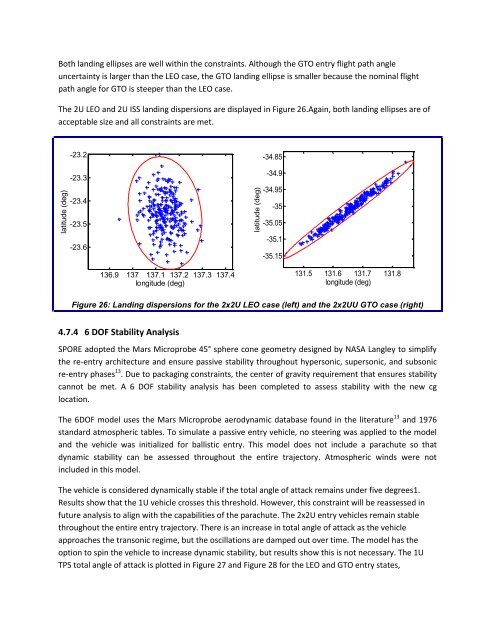SPORE Mission Design - Georgia Tech SSDL - Georgia Institute of ...
SPORE Mission Design - Georgia Tech SSDL - Georgia Institute of ...
SPORE Mission Design - Georgia Tech SSDL - Georgia Institute of ...
You also want an ePaper? Increase the reach of your titles
YUMPU automatically turns print PDFs into web optimized ePapers that Google loves.
latitude (deg)<br />
latitude (deg)<br />
Both landing ellipses are well within the constraints. Although the GTO entry flight path angle<br />
uncertainty is larger than the LEO case, the GTO landing ellipse is smaller because the nominal flight<br />
path angle for GTO is steeper than the LEO case.<br />
The 2U LEO and 2U ISS landing dispersions are displayed in Figure 26.Again, both landing ellipses are <strong>of</strong><br />
acceptable size and all constraints are met.<br />
-23.2<br />
-23.3<br />
-23.4<br />
-34.85<br />
-34.9<br />
-34.95<br />
-35<br />
-23.5<br />
-23.6<br />
-35.05<br />
-35.1<br />
-35.15<br />
136.9 137 137.1 137.2 137.3 137.4<br />
longitude (deg)<br />
131.5 131.6 131.7 131.8<br />
longitude (deg)<br />
Figure 26: Landing dispersions for the 2x2U LEO case (left) and the 2x2UU GTO case (right)<br />
4.7.4 6 DOF Stability Analysis<br />
<strong>SPORE</strong> adopted the Mars Microprobe 45° sphere cone geometry designed by NASA Langley to simplify<br />
the re-entry architecture and ensure passive stability throughout hypersonic, supersonic, and subsonic<br />
re-entry phases 13 . Due to packaging constraints, the center <strong>of</strong> gravity requirement that ensures stability<br />
cannot be met. A 6 DOF stability analysis has been completed to assess stability with the new cg<br />
location.<br />
The 6DOF model uses the Mars Microprobe aerodynamic database found in the literature 13 and 1976<br />
standard atmospheric tables. To simulate a passive entry vehicle, no steering was applied to the model<br />
and the vehicle was initialized for ballistic entry. This model does not include a parachute so that<br />
dynamic stability can be assessed throughout the entire trajectory. Atmospheric winds were not<br />
included in this model.<br />
The vehicle is considered dynamically stable if the total angle <strong>of</strong> attack remains under five degrees1.<br />
Results show that the 1U vehicle crosses this threshold. However, this constraint will be reassessed in<br />
future analysis to align with the capabilities <strong>of</strong> the parachute. The 2x2U entry vehicles remain stable<br />
throughout the entire entry trajectory. There is an increase in total angle <strong>of</strong> attack as the vehicle<br />
approaches the transonic regime, but the oscillations are damped out over time. The model has the<br />
option to spin the vehicle to increase dynamic stability, but results show this is not necessary. The 1U<br />
TPS total angle <strong>of</strong> attack is plotted in Figure 27 and Figure 28 for the LEO and GTO entry states,
















